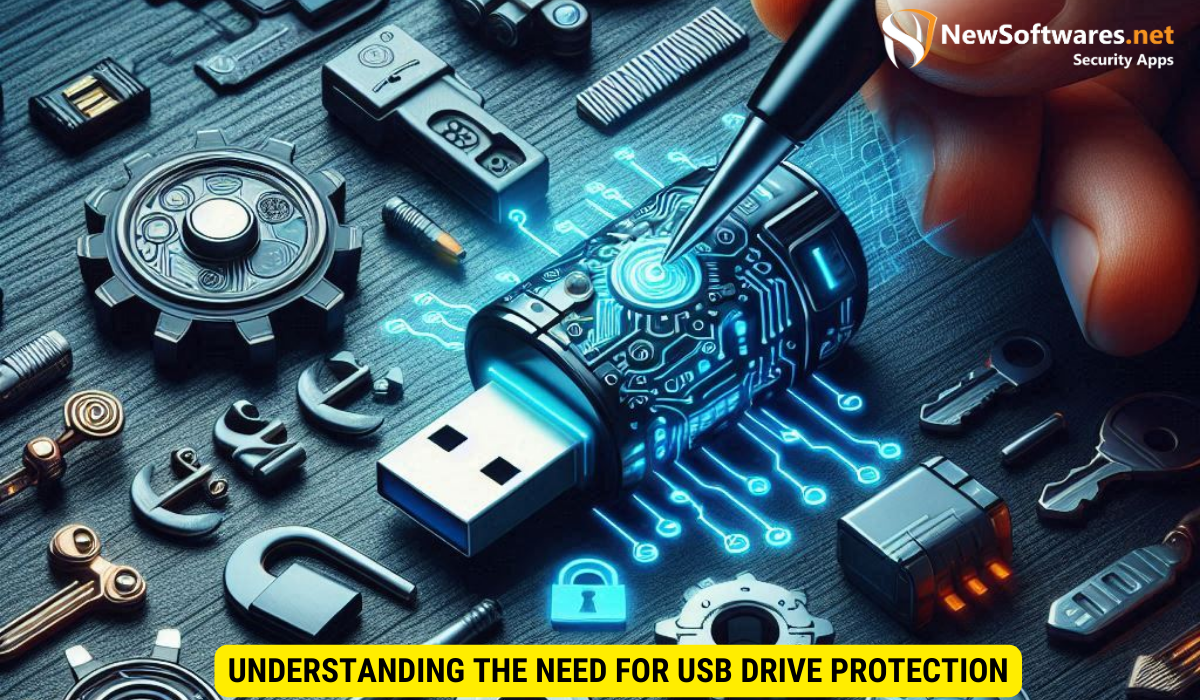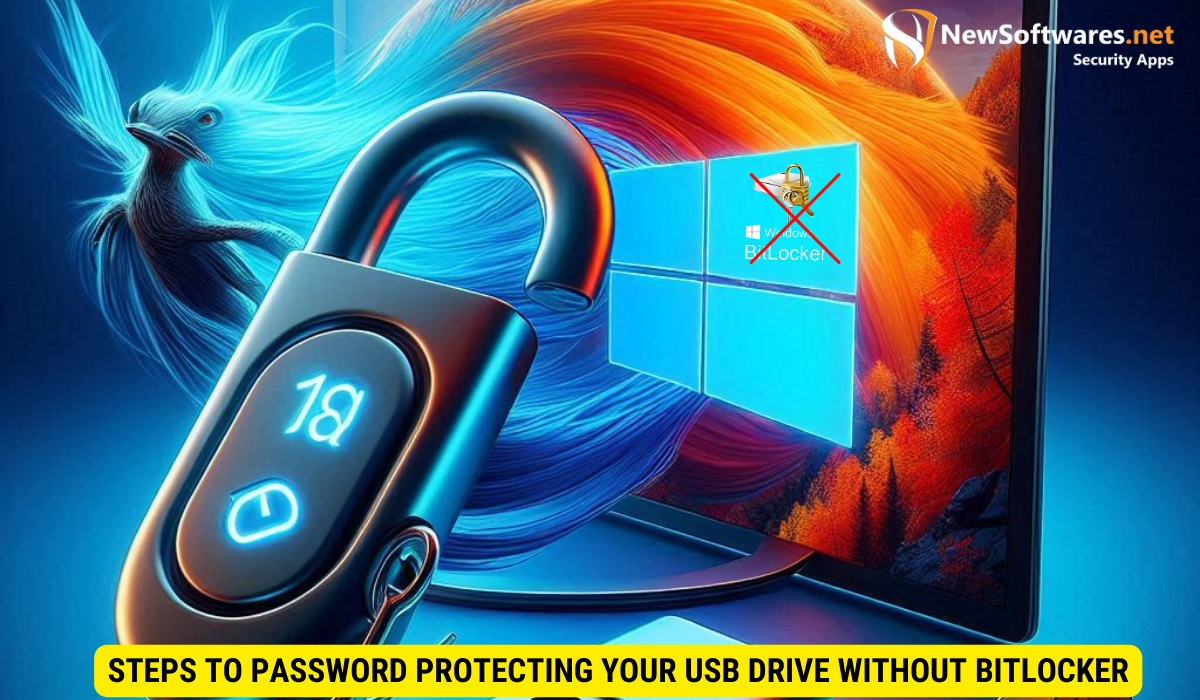To password protect a USB drive without BitLocker, you can consider the following methods:
- Use USB Encryption Software: Tools like iSumsoft USBCode or Cocosenor USB Lock Tuner can encrypt and lock your USB drive with a password.
- VeraCrypt: An open-source utility that allows you to create an encrypted container on your USB drive.
- Windows PowerShell: Encrypt and decrypt a USB drive using commands in PowerShell.
- Third-Party Tools: Some tools offer easy and quick encryption without the need for BitLocker.
- 7-Zip or WinRAR: Create a password-protected archive that you can store on your USB drive.
In today’s digital age, the security of our personal data has become more important than ever. With the widespread use of USB drives for storing and transferring files, it is crucial to protect the sensitive information they contain. While BitLocker is a popular tool for password protecting USB drives, it may not be available on all systems. I will explore alternative methods to password protect your USB drive without relying on BitLocker. I will discuss the need for USB drive protection, the risks of leaving your USB drive unprotected, and various protection methods you can consider. Additionally, I will also provide a step-by-step guide to password protecting your USB drive, troubleshooting common issues, and maintaining the security of your USB drive.
Understanding the Need for USB Drive Protection

In today’s data-driven world, our USB drives often carry a wealth of confidential information, from financial data to personal documents. It is vital to understand the importance of protecting this data from unauthorized access. By implementing password protection, you add an extra layer of security that ensures only authorized individuals can access the information stored on your USB drive.
Furthermore, in addition to password protection, encryption is another effective method to safeguard the data on your USB drive. Encryption converts the data into a coded format that can only be deciphered with the correct encryption key. This means that even if the USB drive falls into the wrong hands, the data remains secure and inaccessible without the encryption key.
The Importance of Data Security
Data security is crucial in safeguarding sensitive information from unauthorized access, theft, or misuse. USB drives are commonly used to transport data, which makes them susceptible to loss or theft. By password protecting your USB drive, you reduce the risk of a security breach and protect your valuable data from falling into the wrong hands.
Moreover, data security compliance regulations such as GDPR (General Data Protection Regulation) and HIPAA (Health Insurance Portability and Accountability Act) require organizations to implement measures to protect sensitive data, including data stored on USB drives. Failure to comply with these regulations can result in severe penalties and damage to an organization’s reputation.
Risks of Unprotected USB Drives
Leaving your USB drive unprotected poses significant risks to your data security. If your USB drive gets lost, stolen, or accessed by someone without your permission, your personal information, business documents, or other sensitive data can be compromised. Not only can this lead to identity theft or financial loss, but it can also harm your reputation and business operations.
Additionally, malware and viruses can easily spread through unprotected USB drives, infecting not only your device but potentially spreading to other computers and networks. By password protecting and regularly scanning your USB drive for malware, you can prevent these security threats and ensure the integrity of your data.
Exploring Alternatives to BitLocker
While BitLocker is a widely used tool for password protecting USB drives, it may not be available or compatible with all systems. Fortunately, there are several alternative protection methods you can consider.
Pros and Cons of Different Protection Methods
Before choosing a protection method, it is essential to understand the pros and cons of each. Some methods may offer greater ease of use, while others may provide stronger encryption. By evaluating different options, you can select the method that best suits your needs and preferences.
Compatibility of Various Protection Tools
In addition to understanding the pros and cons, considering the compatibility of different protection tools is crucial. Not all protection tools work seamlessly with all operating systems, so it is vital to ensure the tool you choose is compatible with your system to avoid any compatibility issues.
Steps to Password Protecting Your USB Drive Without Bitlocker

If BitLocker is not an option for you, there are alternative ways to password protect your USB drive. Let’s take a closer look at the steps involved:
Choosing the Right Protection Software
The first step in password protecting your USB drive without BitLocker is selecting the appropriate protection software. There are numerous third-party tools available for this purpose, each offering different features and levels of security. Research and select a software that fits your requirements.
Detailed Instructions for Password Protection
Once you have chosen the protection software, follow these step-by-step instructions to password protect your USB drive:
- Connect your USB drive to your computer and ensure it is recognized.
- Install and launch the selected protection software.
- Select the USB drive you want to password protect from the software’s interface.
- Set a strong and unique password for your USB drive.
- Customize any additional security settings offered by the software, such as encryption levels or auto-locking features.
- Click the “Protect” or “Encrypt” button to initiate the password protection process.
- Wait for the software to complete the encryption process, ensuring that all your data is securely protected.
- Test the password protection by disconnecting and reconnecting the USB drive, and entering the set password when prompted.
Following these steps will enable you to effectively password protect your USB drive without relying on BitLocker.
Troubleshooting Common Issues
While password protecting your USB drive, you may encounter some common issues. It is essential to know how to deal with these issues effectively.
Dealing with Forgotten Passwords
If you forget the password for your protected USB drive, it can be alarming. However, many protection software offer password recovery options. Ensure you familiarize yourself with these options and follow the instructions provided by the software in case you forget your password.
Resolving Software Compatibility Issues
If you face compatibility issues between the protection software and your system, you may need to consider alternative protection methods or try different software that is compatible with your operating system. Always ensure you verify the system requirements and compatibility before choosing a protection tool.
Maintaining Your USB Drive’s Security
Once you have successfully password protected your USB drive, it is essential to maintain its security to ensure your data remains protected in the long run.
Regularly Updating Your Protection Software
As with any software, it is vital to keep your protection software up to date. Updates often include crucial security patches and improvements that can enhance the protection of your USB drive. Regularly check for updates from the software provider and install them promptly.
Best Practices for Secure USB Usage
In addition to password protection, implementing best practices for secure USB usage can further enhance the security of your data. These practices include never leaving your USB drive unattended, being cautious with shared or public computers, and regularly scanning your USB drive for malware.
Key Takeaways
- Password protecting your USB drive is crucial for securing sensitive information.
- BitLocker may not be available or compatible with all systems, so exploring alternative protection methods is necessary.
- Selecting the right protection software and following a step-by-step guide can help you effectively password protect your USB drive.
- Troubleshooting common issues, such as forgotten passwords or software compatibility problems, is essential for maintaining USB drive security.
- Regularly updating your protection software and implementing best practices for secure USB usage are vital for long-term security.
FAQs
1. Can I password protect a USB drive on any operating system?
While most protection software is compatible with multiple operating systems, it is important to check the system requirements and compatibility information provided by the software provider before proceeding with password protection.
2. What happens if I lose my password for the password-protected USB drive?
Many protection software offer password recovery options. Refer to the software’s documentation or support resources for instructions on how to recover or reset your password.
3. Are there free alternatives to password protect a USB drive?
Yes, there are free alternatives available, but they may have limitations in terms of features or security. It is essential to thoroughly research and choose a reputable and reliable free protection software if you opt for this route.
4. Is password protection the only way to secure a USB drive?
No, there are other security measures you can implement, such as hardware encryption or biometric authentication. However, password protection remains a widely accessible and effective method for securing your data.
5. How often should I update my protection software?
You should regularly check for updates from the software provider and install them as soon as they become available. This helps ensure that your protection software remains up to date with the latest security patches and enhancements.
Conclusion
In conclusion, password protecting your USB drive without relying on BitLocker is essential for securing your sensitive data. By understanding the need for USB drive protection, exploring alternatives to BitLocker, and following a steps provided above, you can effectively protect your USB drive. Remember to troubleshoot common issues, maintain your USB drive’s security through regular updates and best practices, and implement additional security measures if required. By following these guidelines, you can ensure the security of your USB drive and the confidentiality of your data.
